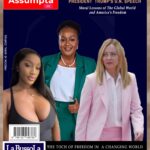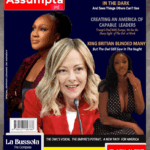Assumpta News Magazine
Presents: “The Lawyer” – A Special Edition
📅 Coming Monday, February 3, 2025
📍 Visit: assumptagh.live/
News Week Theme: Journalism of Neglected Topics
Featured Article:
Looting the DRC: Whitewashing Mineral Theft While Targeting Its People
The continuous suppression of truth and the secrecy surrounding America, Britain, the EU, and Belgium’s historical and ongoing exploitation of the Democratic Republic of Congo (DRC) are not accidental flaws in an otherwise transparent global system. Instead, these actions serve the economic and political interests of powerful nations—interests that have kept the Congolese people in the dark about the real forces shaping their suffering.
In Collaboration with African Stream: Assumpta Newsletters Publication
Join the Dialogue With:
- Serwaa Amihere
- Femi Adunyame
- Berla Mundi
- Assumpta Gahutu (CEO of Assumpta Publications & Principal of Babies and Todds)
Stay Informed. Stay Engaged.




🔥 SOMETHING BIG IS COMING…
https://www.instagram.com/hairsenta?igsh=MXAzOThhNGZ0Nm15dQ==🔥
Ladies, are you ready for the ultimate transformation?
✨ Luxury. Volume. Confidence. ✨
Something game-changing is about to hit the beauty world, and it’s more than just hair—it’s a statement. Hair Senta is bringing you an exclusive hair extension that will redefine elegance, power, and sophistication.
💎 Unmatched Quality
💎 Seamless Blends
💎 Unstoppable Confidence
But here’s the catch… Only the bold will get the first look.
Stay tuned. The countdown begins NOW. Are you ready?
📍 Follow Hair Senta. The secret will be revealed soon.

Introduction
The Democratic Republic of Congo (DRC), a land of immense natural wealth, remains one of the most conflict-ridden regions in the world. For decades, the DRC has been at the centre of a silent war—a war not just for power, but for control over its vast mineral resources. The world’s demand for cobalt, coltan, lithium, and gold—essential for modern technology—has fueled endless cycles of violence, displacement, and suffering for millions of Congolese people.
Yet, instead of addressing the real causes of the crisis, the global media and political narratives often oversimplify the conflict, painting it as an internal ethnic struggle while ignoring the deeper geopolitical and economic interests at play.
This edition of Assumpta Weekly News Magazine takes a bold stand to expose the hidden truths behind the war in the DRC. We explore the historical injustices, the role of Western and regional powers, and the urgent need for an African-led political solution to end the suffering.
While the world remains distracted by other global events, the Congolese people continue to pay the highest price—massacres, displacement, economic deprivation, and political instability. It is time to break the silence, challenge misinformation, and demand justice.

The M23 Rebels Issue Explained
Before blaming Rwanda for the M23 rebellion in the Democratic Republic of Congo (DRC), it’s important to understand the historical and geopolitical context of what is happening in eastern Congo.
How Did It All Start?
The common narrative in the media is that Rwanda is backing M23 rebels while the DRC government is fighting against them to reclaim eastern Congo. However, the reality is far more complex. To understand this conflict, we need to go back to its roots.
The Colonial Origins of the Conflict

During the infamous Berlin Conference of 1884–1885, European powers divided Africa without regard for existing ethnic or tribal boundaries. As a result:
- Belgium colonized the Congo Free State (later the Belgian Congo, now DRC).
- Germany took control of Rwanda and Burundi (then known as German East Africa, along with present-day Tanzania).
- Britain colonized Uganda and parts of East Africa.
This arbitrary partitioning led to the division of many African ethnic groups across multiple borders. One such group was the Tutsis, whose historical territory was split between Rwanda and what was then Zaire (now the DRC).
Who Are the M23 Rebels, and Why Are They Fighting?

An illustration depicting the M23 rebels and their conflict in the DRC, highlighting their armed presence, clashes with government forces, and the humanitarian impact.
M23 (March 23 Movement) is a Tutsi-led rebel group that emerged in 2012, primarily composed of former soldiers from the CNDP (National Congress for the Defense of the People), another Tutsi militia that had previously integrated into the Congolese army.
The key question is: Who are they defending themselves against?
M23 claims to be fighting against:
- The Congolese government, which they accuse of persecuting Tutsis in eastern Congo.
- Hutu rebel groups, particularly the Democratic Forces for the Liberation of Rwanda (FDLR)—a militia composed of former genocidaires who fled Rwanda after the 1994 genocide and have continued attacking Tutsi communities in eastern Congo.
Why Does the DRC Remain in Conflict?
The DRC has long struggled with governance issues, corruption, and foreign exploitation. The country is home to vast reserves of minerals, including cobalt, coltan, lithium, and uranium—essential for modern technology like smartphones, drones, and electric car batteries.
However, instead of these resources benefiting the Congolese people, they have become the focus of foreign exploitation and internal power struggles. Western powers, including the United States, France, Belgium, and the EU, have historically backed different factions within the DRC to maintain access to these resources.
In many cases, Congolese government forces have forcibly displaced local populations from mineral-rich areas, allowing foreign companies to mine under the protection of UN peacekeepers—who, critics argue, serve Western corporate interests rather than the Congolese people.
Why Did the Tutsis in Eastern Congo Form the M23?
Given this reality, Tutsi communities in eastern Congo—historically persecuted and targeted by both the Congolese government and Hutu militias—felt the need to arm themselves for survival. This led to the formation of groups like the Banyamulenge militias, and later, M23, to defend their lands and rights.
The DRC government, instead of recognizing the Banyamulenge (Congolese Tutsis) as legitimate citizens, has often treated them as foreigners and pushed for their expulsion, claiming they should “return to Rwanda”—even though they have lived in eastern Congo for generations.
How Does Rwanda Fit Into This Conflict?
Rwanda’s involvement in the M23 issue is based on three key factors:

- Ethnic Ties and Historical Unity – The Tutsis in the DRC and Rwanda share the same language, culture, and identity. When they sought help from Rwanda, the Rwandan government supported them, seeing them as their people.
(2) Security Concerns – After the 1994 Rwandan Genocide, many of the perpetrators (Hutu extremists) fled to the DRC and formed the FDLR militia. Rwanda has since worked to contain these groups, often relying on Tutsi fighters in the DRC to neutralise this threat.
- Economic Interests – The safest route for transporting minerals from eastern Congo is through Rwanda and Uganda. Rwanda benefits from facilitating the export of these minerals, strengthening its economy in the process.
The Role of Western Powers

An illustration depicting the role of Western powers in the DRC conflict, highlighting resource extraction, exploitation, and foreign influence.
The DRC government has often portrayed itself as a victim while working with Western corporations to exploit Congo’s vast resources. Under the watch of the Congolese government, supported by UN peacekeepers, local communities—including the Banyamulenge—have been forcibly displaced, making room for Western mining operations.
The Bigger Picture: A War Over Resources
At its core, the M23 conflict is not just about ethnicity—it’s about control over one of the most mineral-rich regions in the world. With the global shift toward electric vehicles, smartphones, and military technologies, the demand for cobalt, lithium, and coltan has skyrocketed.
Countries like the United States, France, Belgium, and the EU seek continued access to these resources. This is why the Congolese government, backed by Western powers, is trying to take full control of eastern Congo by pushing out the Tutsis, who historically occupy these lands.
Conclusion: What Is the Real Solution?
To resolve this crisis, the world must acknowledge the real causes of the war in eastern Congo:
- Foreign exploitation of Congo’s resources at the expense of local populations.
- Systematic persecution of Congolese Tutsis, who are being forced out of their land.
- Regional security threats, particularly the continued presence of Hutu extremist militias (FDLR) in the DRC.
A just political solution must include:
- Recognising the Banyamulenge (Congolese Tutsis) as legitimate Congolese citizens and ensuring their protection.
- Addressing the presence of FDLR militias in eastern Congo, which continue to pose a threat to Rwanda and local communities.
- Stopping the exploitation of Congo’s resources by foreign companies and governments.
- Encouraging regional cooperation between the DRC, Rwanda, and Uganda to establish long-term stability.
Without addressing these core issues, the cycle of violence, displacement, and exploitation will continue—fueling more wars for future generations.
Newsletter: The M23 Conflict – A Call for Lasting Peace
Breaking the Cycle of Violence in Eastern Congo
The ongoing crisis in eastern Congo is a humanitarian and geopolitical catastrophe, driven by historical injustices, ethnic tensions, and external exploitation. With millions displaced and entire communities devastated, this war is fueled by competing interests over the region’s vast mineral wealth.
While media narratives often frame the conflict as a battle between M23 rebels and the Congolese government, the reality is far more complex. A military solution alone will not work—only a bold, just, and inclusive political settlement can bring lasting peace.
What Must Be Done?
1. A Political Solution is the Only Path
As Vasily Nebenzya rightly pointed out, military efforts will not bring peace. Sustainable stability requires a comprehensive political agreement that guarantees security, justice, and coexistence for all communities.
2. Inclusion and Protection for All Communities
Thabo Mbeki has emphasized the urgent need for recognition and protection of the Banyamulenge and other Congolese of Rwandan origin. These communities have been historically marginalized and persecuted. Any lasting solution must safeguard their citizenship rights while addressing grievances from all affected communities.
3. Breaking the Cycle of Retaliation
Generations of trauma and revenge have fueled an endless war. Any true peace process must include accountability for past atrocities on all sides. Truth, justice, and reconciliation must take precedence over continued cycles of revenge and violence.
4. Ending the Rwanda-Congo Divide
The growing animosity between Rwanda and the DRC serves no one except those profiting from instability. Instead of fueling hostilities, both nations must engage in direct diplomatic talks to dismantle the networks of violence that have plagued the region for decades.
5. Pan-African Unity Against Violence
The conflict in the DRC has been manipulated by external powers seeking control over its vast resources. African nations must take ownership of the peace process. The African Union (AU), the East African Community (EAC), and grassroots movements must step up to restore African agency in resolving African conflicts.
The Urgent Question: Who Will Lead This Peace Process?
The one thing that can end this war is a courageous political agreement that ensures:
✅ Security for all communities
✅ Full citizenship rights for persecuted groups
✅ Accountability and justice for past crimes
✅ An end to foreign-backed exploitation of Congolese resources
The world is watching. The question now is: Who will step up to lead this peace process with the courage and vision required to end this suffering once and for all?
This is a moment of truth for leadership in the DRC, Rwanda, and the international community. Will they choose war, or will they choose peace?
Join the Conversation
We invite leaders, policymakers, activists, and citizens to engage in solutions that will finally bring lasting peace to eastern Congo.
- Share your thoughts
- Support peace initiatives
- Demand that the world does not turn away from this crisis
Together, we can break the cycle of violence and build a future of stability, justice, and prosperity for the people of the DRC.
Your dialogue is already well-structured and impactful, but I’ll refine it for clarity, flow, and emphasis while maintaining the depth of the discussion. Here’s a polished version:
[DIALOGUE BEGINS]
Introduction
Serwaa Amihere (Host & Journalist):
Good evening, and welcome to this special edition of Assumpta Weekly News Magazine. Tonight, we uncover one of the most underreported yet devastating crises of our time—the war in the Democratic Republic of Congo (DRC).




Despite its vast natural wealth, the DRC remains trapped in conflict, displacement, and economic ruin. Why? Because global powers and multinational corporations profit from its instability rather than work toward peace.

Frema Adunyame (Investigative Journalist):
And let’s be clear—this isn’t just about ethnic conflicts, as mainstream media often suggests. This is a systematic economic and political sabotage orchestrated by Western nations—including the U.S., Britain, Belgium, and France—alongside corporate giants who benefit from Congo’s resources. For decades, millions have died, and yet the world remains silent. The real question is: Who truly benefits from this chaos?

Berla Mundi (Media Personality):
Tonight, we dissect the hidden forces fueling this crisis, from historical exploitation to modern geopolitical interests. To guide this conversation, we welcome Assumpta Gahutu, CEO of Assumpta Publications & Principal of Babies and Todds. Assumpta, thank you for joining us.

Assumpta Gahutu (CEO & Advocate):
Thank you, Serwaa. I appreciate this platform and commend Assumpta Weekly News
1. The Root of the Crisis – Colonialism, Corporate Greed & Global Complicity

Frema-Adunyame:
Assumpta, let’s start with history. The DRC is one of the richest countries on Earth in natural resources, yet it remains one of the poorest and most unstable. How did we get here?

Assumpta Gahutu:
Congo’s suffering is not accidental—it is by design.
From King Leopold II’s reign (1885–1908)—where 10 million Congolese were killed under forced labour—to Belgium’s continued economic stranglehold even after so-called independence in 1960, the exploitation never stopped.
When Patrice Lumumba, Congo’s first Prime Minister, fought for true independence, he was assassinated with Western backing. This paved the way for decades of instability, military coups, and corporate-backed dictatorships.

Berla Mundi:
So, Congo’s instability is not just a failure of governance, but a deliberate geopolitical strategy?

Assumpta Gahutu:
Exactly! If the DRC had stability and full control over its resources, Western economies would suffer, and multinational corporations would lose billions. This is why every attempt at peace is sabotaged.
2. Multinational Corporations & The Business of War

Serwaa Amihere:
Let’s talk about corporate involvement. Congo’s wealth continues to be extracted while its people suffer in extreme poverty. Who are the biggest beneficiaries?

Assumpta Gahutu:
Multinational corporations—particularly from the U.S., Europe, and China—are at the centre of this exploitation.
- Apple, Tesla, Samsung, and Microsoft – rely on Congo’s cobalt for their batteries.
- Defence contractors – use Congolese rare-earth minerals for military technology.
- Luxury brands – buy conflict gold while claiming ethical sourcing.
These companies hide behind third-party suppliers to avoid accountability, but the reality is well-documented: child labour, mass killings, and systematic displacement sustain their industries.
3. The M23 Conflict & Rwanda’s Role – The Bigger Picture

Frema Adunyame:
The M23 rebellion in eastern Congo has dominated recent headlines. Many blame Rwanda for supporting the rebels, but is this the full story?

Assumpta Gahutu:
No, the narrative is incomplete. While Rwanda’s involvement is real, we need to ask:
Who truly benefits from the continued war in the DRC?
- Western nations fund the Congolese government and rebel groups to ensure continued access to minerals.
- M23 and other militias are proxies for foreign interests securing strategic mining zones.
- Every peace deal is deliberately undermined by those profiting from Congo’s instability.
The idea that this is just an “African tribal war” is false—this is an internationally controlled conflict over resources. The common narrative is that Rwanda is backing the M23 rebels, while the DRC government is simply defending its sovereignty. But the truth is far more complex, rooted in colonial history, ethnic tensions, and resource exploitation.

Frema Adunyame: Colonial history? How does that connect to the current conflict?

Assumpta Gahutu: Well, during the Berlin Conference of 1884–1885, European powers carved up Africa without considering existing ethnic boundaries. This split many ethnic groups across different countries. One of these groups was the Tutsis, who historically lived in what is now Rwanda and eastern Congo.

Serwaa Amihere: So, the M23 rebels are Tutsis who have lived in eastern Congo for generations?

Assumpta Gahutu: Exactly. The M23 movement, which emerged in 2012, is mostly made up of Congolese Tutsis. They claim they are fighting against the DRC government, which they accuse of persecuting them, and against Hutu militias—specifically the FDLR.

Berla Mundi: The FDLR? Who are they?

Assumpta Gahutu: The FDLR is a militia composed of former Hutu extremists who fled Rwanda after the 1994 genocide. They’ve been in eastern Congo for decades, attacking Tutsi communities there. That’s why the M23 says it took up arms—to protect itself from these attacks.

Frema Adunyame: But why hasn’t the DRC government neutralized the FDLR if they pose such a threat?

Assumpta Gahutu: That’s the big question. Instead of addressing the issue, the DRC government has often treated the Congolese Tutsis—known as the Banyamulenge—as foreigners, telling them to “go back to Rwanda,” even though they’ve lived in eastern Congo for generations and let’s not forget that Congo today is the same land of Rwanda but was divided by the Europeans, so the Tutsis in Congo today live on their land.

Serwaa Amihere: But some say Rwanda is involved in this conflict. Is that true?

Assumpta Gahutu: Rwanda’s involvement is tied to three main factors.
(1) First, ethnic ties—the Tutsis in the DRC and Rwanda share the same heritage, so Rwanda sees them as their people.
(2)Second, security—Rwanda views the FDLR in the DRC as a direct threat because they’re linked to the 1994 genocide perpetrators.
(3) Third, economic interests—minerals from eastern Congo, like cobalt and coltan, often pass through Rwanda, boosting its economy.

Berla Mundi: That brings us to the bigger issue—resources. How does that play into this conflict?

Assumpta Gahutu: This war isn’t just about ethnicity; it’s about controlling one of the world’s richest mineral regions. Congo has vast reserves of cobalt, coltan, and lithium—critical for making smartphones, electric cars, and military technology. Western powers, including the U.S., France, and Belgium, have historically supported different factions to maintain access to these resources.

Frema Adunyame: So, you’re saying Western countries are fueling this war behind the scenes?

Assumpta Gahutu: That’s right. While the DRC government presents itself as a victim, it works with foreign companies to exploit Congo’s wealth. In many cases, local communities—including the Tutsis—are forcibly displaced to make way for mining operations protected by UN peacekeepers.

Serwaa Amihere: So what’s the solution? How can this cycle of violence end?

Assumpta Gahutu: First, the Banyamulenge Tutsis must be recognized as Congolese citizens, ensuring their protection. Second, the FDLR militia must be disarmed. Third, foreign powers need to stop exploiting Congo’s resources at the expense of local people. Finally, real regional cooperation between the DRC, Rwanda, and Uganda is crucial for lasting peace.

Berla Mundi: Assumpta, this has been an eye-opening discussion. It’s clear that the M23 conflict is more than just a local issue—it’s a geopolitical and economic battle with deep historical roots. Thank you for breaking it down for us.

Assumpta Gahutu: My pleasure, Berla. This is a complex issue, but understanding the real causes is the first step toward a solution.
4. A Path to Peace – What Must Be Done?

Berla Mundi:
Given this, what concrete steps can be taken to end this cycle of violence?

Assumpta Gahutu:
- Pan-African Unity & Resistance to Foreign Control – African nations must stop allowing foreign forces to dictate peace agreements and economic policies.
- Resource Nationalization – The DRC must control its mining sector, instead of allowing multinationals to extract wealth without accountability.
- Legal Accountability – Western corporations and governments must be held responsible for fueling conflict.
- End the Rwanda-Congo Divide – Rather than war, direct diplomatic talks must replace Western-backed hostilities between Rwanda and the DRC.
- Media Transparency – African journalists must expose the real story, challenging Western narratives that protect corporate and state complicity.
Conclusion – Who Will Take Action?

Serwaa Amihere:
The world is watching. Will we continue to let multinational corporations profit from bloodshed, or will African leaders reclaim control over their resources and future?

Frema-Adunyame:
Africa cannot wait for the West to act. Only African unity and leadership can break this cycle of exploitation.

Assumpta Gahutu:
Thank you for having me. The time for silence is over. The truth must be told, and justice must be demanded.
SGI-Our Shared Humanity.










